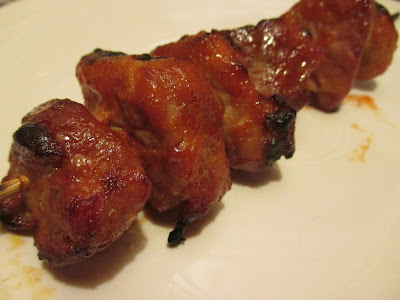Long story short: Here is a bunch of stuff I didn’t think I liked (Raw chickpeas! Pepperoncini! Artichokes!) in a big bowl with a lot of tasty salty briny things, all swimming in an amazing garlicky oregano dressing. I love it.
Long story slightly longer: My friend S brought a delicious pasta salad to one of our picnics earlier this summer, explaining that she’d adapted it from the Smitten Kitchen version of Nancy Silverton’s chopped salad from Mozza. Despite the presence of the aforementioned stuff I didn’t think I liked, I adored it and immediately wanted to re-create it for myself (and A, who was out of town and had thus missed out). I did, and we both loved it.
I have a surfeit of pasta recipes, though, plus I’m trying not to eat pasta every single week, so I also wanted to try this in straight-up salad form, but the traditional iceberg lettuce format of the original didn’t appeal to me. Considering this concoction is chock-full of items cured, pickled, and preserved, I thought it could use a little more veggie oomph, and kale seemed a natural fit. It plays well with Italian ingredients, its sturdiness stands up to the heavy dressing, and it has enough flavor of its own to avoid getting lost in the shuffle. I was right; this made an excellent salad—a truth that was tested when A had to fly to Indiana unexpectedly on the day I’d planned to make it, leaving me with all six servings to eat on my own. Sure, I was a bit weary of antipasto salad by the end of the week, but none went uneaten. It was really that good.
A few notes: The Smitten Kitchen recipe called for way, way too much salt considering all the processed ingredients bringing serious sodium of their own. I halved it and it was plenty. I also halved the salami and cheese quantities and still thought there was plenty of each. I’m not a huge provolone fan and had trouble finding any (except presliced sandwich cheese) at Trader Joe’s, so I used Pecorino Romano. For the pasta salad I cut it into matchsticks, but that made it too assertive, so I simply shredded it for the kale version and it was perfect. S had added a few pickled cherry peppers to her salad for a bit of heat, and I followed her lead. She also used artichokes, so I bought some for the very first time and dutifully added them in. I guess they bring another vegetable to the mix, but honestly, artichokes do absolutely nothing for me. They hardly taste like anything. I’ve tried them multiple times in many formats and still don’t understand why people seem to be so gaga for them. I’ll finish the jar, but I’m not sure I’ll bother buying any more in the future. Adding arugula to the pasta version of the salad was also S’s idea, and it brings a nice, fresh, green element to what—let’s face it—is not exactly the healthiest salad on the spectrum. It is, however, a substantial, satisfying, protein-rich, all-seasons crowd-pleasing main dish I’ll be making again and again, in both forms.
4 cloves garlic
1 generous tablespoon dried oregano
1 teaspoon kosher salt
Freshly ground black pepper to taste
2 tablespoons lemon juice
¼ cup red wine vinegar
¼ cup extra-virgin olive oil
1 (15-ounce) can chickpeas, drained and rinsed
1 small red onion, peeled and sliced into paper-thin rings
4 ounces Pecorino Romano cheese, coarsely shredded
4-6 ounces sliced salami, cut into ¼-inch ribbons
4 medium or 8 small pickled pepperoncini, sliced into rings
2-4 pickled cherry peppers, diced (optional)
4-6 jarred artichoke hearts, diced (optional)
1 pint cherry tomatoes, halved or quartered
For the pasta salad:
12 ounces rotini, cooked, drained and rinsed in cold water
6 generous handfuls arugula
For the kale salad:
1 very large or 2 small bunches Tuscan kale, ribs removed, leaves thinly sliced
- To make the dressing, roughly chop the garlic and then add the oregano, salt and up to ½ teaspoon ground pepper. Chop the mixture together and use the side of a knife or a mortar and pestle to make a grainy herb paste. Transfer the paste to a small bowl, then add the lemon juice and vinegar. Mix with a fork, allowing the salt to dissolve, then add the oil and whisk until well combined. The dressing should be thick with garlic and oregano.
- For the pasta salad: Combine the cooled pasta, chickpeas, red onion, cheese, salami, pepperoncini, cherry peppers and artichokes (if using), and cherry tomatoes in a large bowl. Add about half the dressing, toss well, and then add remaining dressing to taste (I used all of it). Adjust seasonings to taste. Fold in the arugula immediately before serving.
- For the kale salad: Combine the shredded kale with about half the dressing in a large bowl. Toss with your hands, massaging the kale until it becomes tender. Let sit for at least 15 minutes while you prepare the other ingredients. Add the chickpeas, red onion, cheese, salami, pepperoncini, cherry peppers and artichokes (if using), and cherry tomatoes to the bowl. Toss well and add remaining dressing to taste (I didn’t quite use all of it). Adjust seasonings to taste.
Time: 30-40 minutes
Leftover potential: Great. For the pasta salad, store the arugula separately and add one generous handful to each serving directly before you eat it.






















